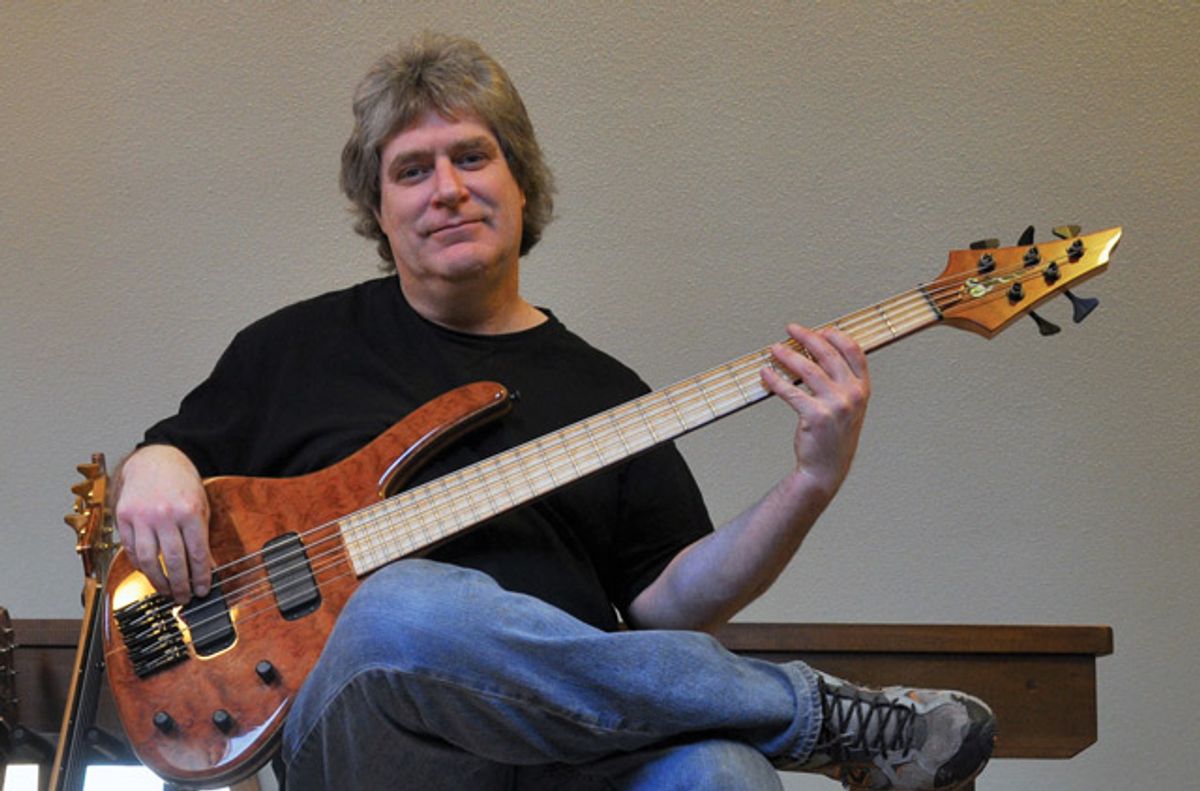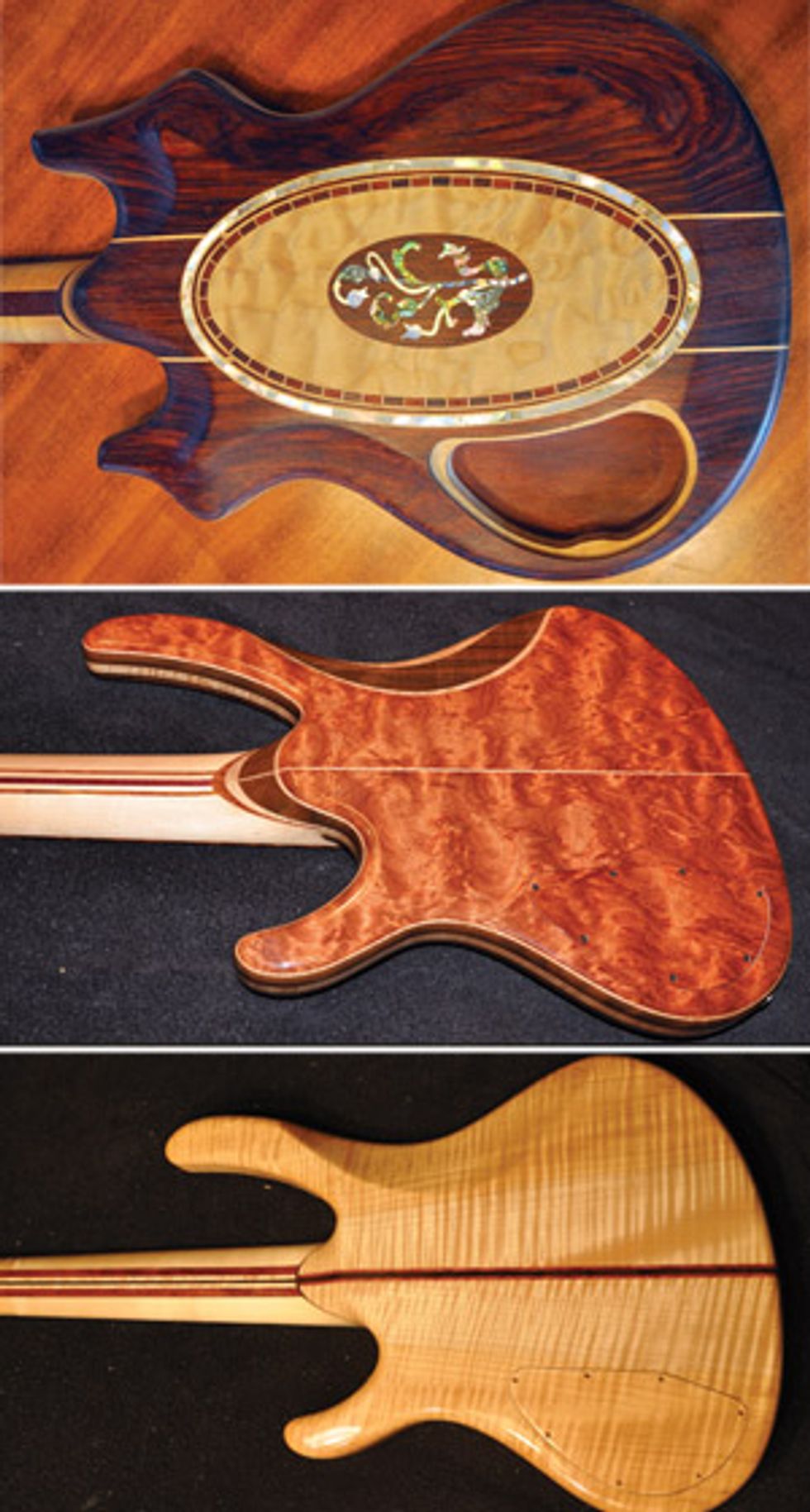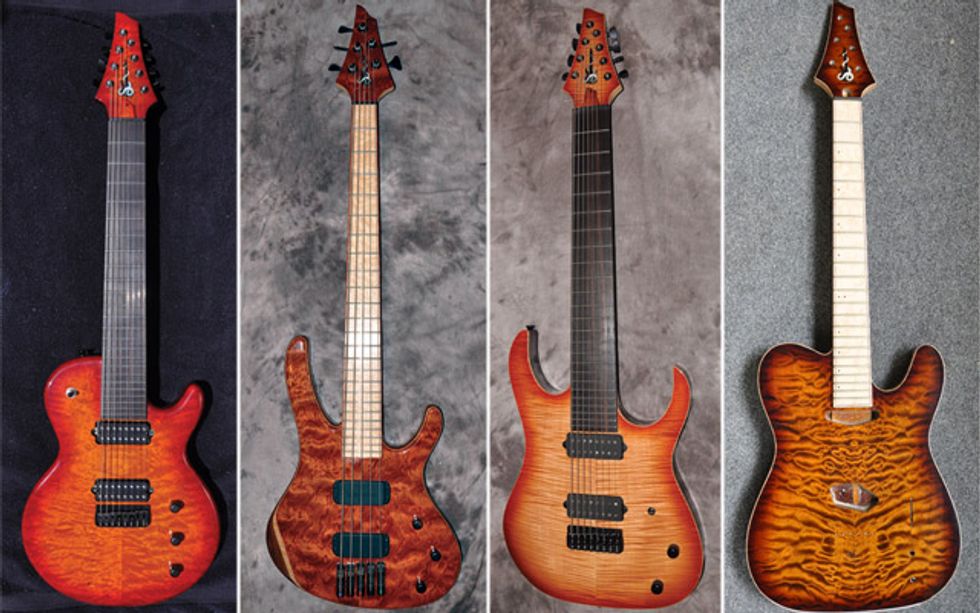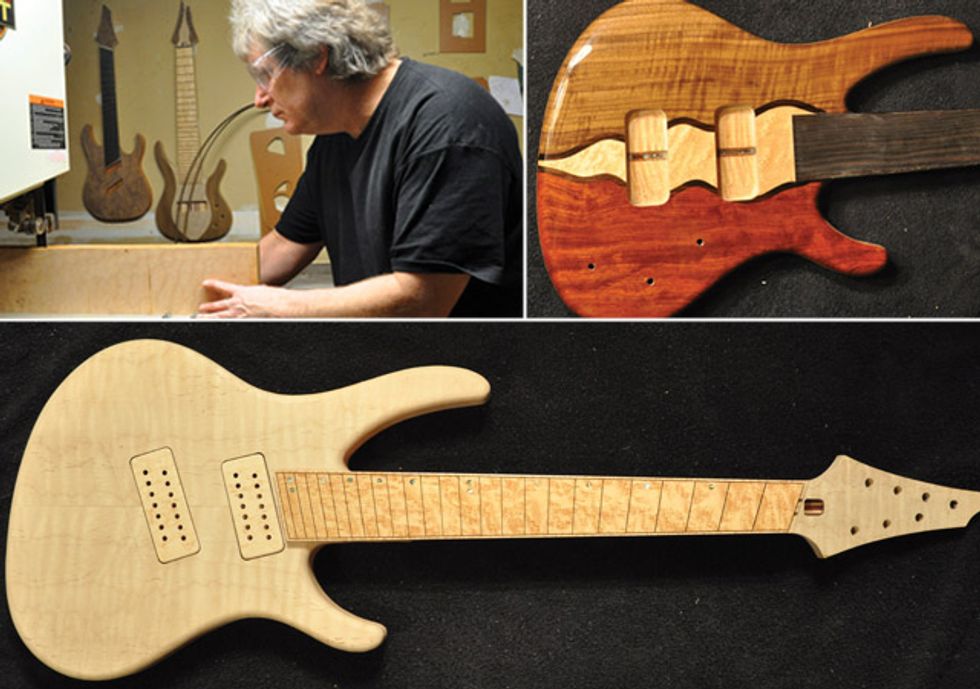
The former Hamer, Washburn, and Dean builder takes boutique shredmachine luthiery to the extreme with an approach that prioritizes local sourcing and one-on-one client engagement.
On an atypically warm, late-December Friday afternoon, Mike Sherman is scrambling to get the last of his holiday orders out the door. The lone builder of custom extended-range guitars has been working 12-hour days for the past five years to produce the 60 or so one-off instruments he sells annually. In the coming year, however, he says he’ll be scaling back his annual ambitions by 20 pieces in hopes of working shorter days: “The hours are just too long,” he says with a sigh.
Although he was recently featured in Robert Shaw’s book Electrified: The Art of the Contemporary Electric Guitar, Sherman doesn’t consider himself a master builder. “When I was contacted about doing it, I thought it was a joke,” he says. Still, he’s been building since he was 14—when he suddenly found himself fatherless and with a garage full of carpentry equipment. “I always wanted to be a musician, and my father was a carpenter and a mason,” he explains. When his father passed away, Sherman recalls, “my mom was thinking about selling his equipment, but I said, ‘Y’know what? Let me start dabbling.’” Tinkering away in the garage, armed with dad’s tools, a few guitar-building books, and plenty of ambition, the teenager built what he now describes as a 7-string, Stratish- looking thing that he was surprised even played. “I’ve been hooked ever since.”
Before going full-time with his own company, Sherman had a long career working for builders like Dean, Hamer, and Washburn. When he was 19, he applied for a job at Hohner and got it. His next guitar gig was a six-month stint at Dean, which proved to be a stepping stone en route to a 15-year, on-again-off-again tenure at Hamer that began in the mid-’80s. “Once I [temporarily] left Hamer to pursue my own guitar building,” he says. “I was always building Sherman guitars at night on my own.” He ended up back there a few years later, only to leave again later for Washburn Guitars. There, he worked alongside legendary luthier Grover Jackson to help launch the company’s custom shop in Chicago. “Ironically,” he laughs, “I wound up going back to Hamer. They came calling—bribing me with zeros—and I accepted.”
That time he stayed with Hamer for a while, running production and helping out in the adjoining Ovation factory until going back to Washburn for a final stint in 2000. But the commute to Washburn’s Chicago facility from Sherman’s New England home was exhausting, especially when he was needed on weekends to help out at home or play local gigs as a sideman. “I was flying out to Chicago, living in a fully furnished motel during the week,” he says. “The hard part about that was that I’d shut the factory down at 2:30 [on Friday] and have to grab all my gear—I’d have a guitar and my clothes with me—head back, and then my wife would pick me up at the airport and I’d have to go straight to a gig. It was trying. Eventually it was like, ‘Okay, I can’t do this anymore, I need to be back home.’” He went full-time with Michael Sherman Guitars in 2003.
Left to right: Lee White’s LP 8-string, Waterfall Bubinga 5-String Bass, 26.5" Scale 8-String, and A work-in-progress T-style
Despite long hours blanketed in sawdust, Sherman says he’s compelled onward by the music people make with his guitars. He’s quick to point out that, although most people think of guitar building as a glamorous business, it’s tedious physical labor. “It’s thankless work sometimes when you have to sand six guitars,” he says. “But when they’re done, you can sit back and look at them and play them. And the look on the customer’s face when they receive it—and the music they make from it—it’s just the most rewarding thing.”
6-String Luxury Machines
While at Hamer and Washburn, Sherman worked with such bigname
artists as Aerosmith’s Joe Perry, Sammy Hagar, No Doubt’s Tom
Dumont, and Cheap Trick’s Rick Nielsen—and many of those players
continued to be supportive of his work as he branched out on his own.
Guitar collector Lee White was introduced to Sherman by chance on the online guitar community Sevenstring.org. Intrigued by photographs of Sherman’s work that he calls “stunning,” White decided to take the plunge and ordered an 8-string instrument. When the neatly wrapped guitar package arrived at White’s office, he was blown away by the complexity and beauty of the instrument. “My jaw completely dropped,” says White of the set-neck “super strat” with a burled-mahogany top and fretboard LEDs. “It was named ‘Bison’ by the Sevenstring.org crew, because the figured wood looked a heck of a lot like a bison’s head.” He didn’t even make it home from work before he ordered another—a set-neck 7-string with a flame-topped mahogany body and a piezo-pickupequipped Floyd Rose tremolo.
After that, White and Sherman hit it off, boozing and bonding over common interests. One day the two went digging through White’s guitar collection and hit on a mutual favorite. “For years,” says White, “I had gone through numerous Washburn N4s, including the coveted Davies models [Ed. note: Stephen Davies is the Seattle-based luthier who invented the Stephen’s Extended Cutaway neck in collaboration with Extreme guitarist Nuno Bettencourt and Washburn]. None of them hit me like this one oddball quilt-top N4. When I pulled that out of the case, Mike immediately said, ‘I remember that one.’” It turns out Sherman had built that very guitar years before while working at Washburn.
“I had been attached to Mike’s work for years before I even knew who the heck he was,” he says. Since then, White has acquired four Shermans—and he has six more on order.
Top Left: Mike Sherman at work in his one-man operation shop in Connecticut. He produces roughly 60 guitars (by himself) annually. Top Right:
Sherman is calling this work in progress his “Flamed Bass.” Finishes are one of the most important processes for Sherman, who says the wrong finish can
ruin hours of tedius work. All of his instruments undergo a 12-step finishing process that can include grain-filling of porous wood, and various degrees of
sanding, dying, coating, and buffing. Bottom: Sherman has formed a niche with “a new breed” of players seeking fanned-fret instruments with 7, 8, 9, and
even 10 strings.
Local Wood, Carefully Guarded
Sherman takes the utmost care when choosing materials for his
creations: He uses quartersawn lumber from local mills, and outsources
only pickups and hardware—veneers and fretboards are
made in-house. “I pride myself on American-made products, and
try to use them wherever possible,” he says. “I deal with [Southern
California-based pickup company] Nordstrand a lot, because
they’re willing to build what I want, and they have a laser cutter
and can accommodate fan-fret pickups.”
If Sherman isn’t getting the right tone out of a certain wood, he’ll manipulate it until it’s just right. “I can tailor the sound,” he says. “Believe it or not, if you glue two pieces of wood together, they become one different type of wood with a voicing all its own.” In this manner, Sherman blends beauty, elegance, and playability into something many players find stunning, both visually and tonally.
Considering this unique mindset with regard to wood, it comes as no surprise that Sherman doesn’t take chances with it. He stores his lumber onsite in a climate-controlled room, where it’s stacked and stickered neatly for up to eight years. “I’m constantly buying lumber I won’t use for a couple of seasons,” he explains. With so much tension in the wood itself—he compares it to a big, hard, sponge that’s constantly growing and retracting in a way that requires constant monitoring—if it’s not sliced, cured, and stored correctly, the pieces begin to warp. “At that point,” he says, “you can only make veneers out of it.”

Top: The Rosebud Tiger Garcia Replica is another work in progress, showcasing Sherman’s talented woodworking skills with an intricate inlay on the back. Middle: Sherman instruments use a set neck that is easily accessible, similar to a neck-through/blended-heel design. Bottom: The back of this Sherman bass showcases unique patterns found in high-quality wood that is locally sourced, carefully stored and climate controlled by Sherman. He experiments tonally with wood choices, pairing different species combinations for specific sounds.
One anecdote illustrates how dedicated he is to proper wood storage: After a startling, pre-Halloween blizzard that left most of the East Coast without electricity for as many as 12 days, Sherman once faced losing his entire stock of lumber. “We were without power for so long that I literally had to run a separate generator just to fire up that room and keep the climate controlled—because one week can really freak out the wood.”
Painstaking Attention to Detail
Sherman isn’t happy unless his designs are as visually striking as they
are user-friendly, and he’s not afraid to be unconventional. “There’s
a new breed of musicians that are fantastic. Most guitar players can
barely handle 6-strings, and these guys are playing 9- and 10-string
guitars—and playing them well. It’s amazing.” Sherman cites these
players because they’re the types coming to him for custom instruments.
“Everyone likes the way I do my set necks,” he says. “They’re
all-access, and don’t hinder your hand. There are no restrictions
going up to the upper frets at all. It’s kind of a neck-through/blended-
heel design, but adapted to a set neck.”
At the time of this interview, Sherman was working on a fannedfret 10-string for a client. Like all his instruments, it was undergoing a unique 12-step finishing process. First, the wood is grain-filled (if necessary): Closed-pore varieties like maple don’t need filling, but more porous woods like mahogany do. Depending on the instrument, this can take up to three hours. “When you have a lot of pin-stripe veneers and accents, some need to be filled, some don’t. So I spend a lot of time masking,” Sherman says.
From there, each piece gets a vinyl wash coat to seal pores, creating a suitable surface for the finish. Though the next step can vary according to client preferences or expediency, usually four clear coats are then applied and then allowed to dry for two days. They’re then sanded and color is applied. After the dying process, Sherman applies four more clear coats, waits two days, sands the instrument, and applies the final four topcoats. The guitar is then allowed to dry for three weeks before final sanding and buffing. “The finishing process takes a month,” he says. “You can’t be impatient in this business. You can have the prettiest woodworking, but if you put a junk finish on it, it’s not going to represent all the work that went into it.”
Addicted to the Rush
Though Sherman says he’d never trade his career for a less hectic
one, he marvels at the workload his business demands. Between the
eccentric and very particular personalities of his clients—“I’ll basically
build whatever a customer wants, within reason,” he says—and
the administrative tasks, there’s never a dull moment. And there’s
always more to do. On top of all the work he puts in on individual
instruments, Sherman says he’s spent many nights lying awake, mulling
over the idea of “going big time” and creating his own line. But
the answer has always been no, because, ultimately, he rather enjoys
the challenges that come with being a build-to-order luthier.


